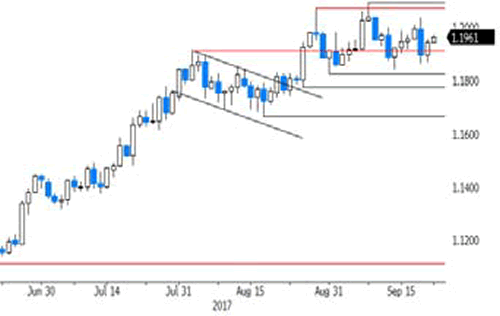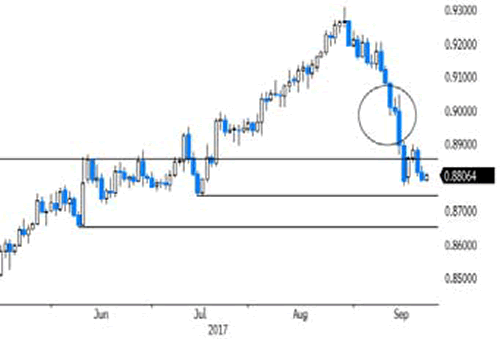Sunrise Market Commentary
- Rates: Profit taking on short positions ahead of the weekend?
North Korea threatened to detonate an H-bomb in the Pacific. Risk aversion reigns in Asia and will dominate at the start of European trading, offering investors the opportunity to take some profit on short positions in the German Bund and US Note future. Central bank speakers (both ECB and Fed) are wildcards. - Currencies: Risk-off blocks post-Fed USD comeback
Yesterday, the dollar failed to extend the gains recorded after the Fed decision on Wednesday. Overnight, sentiment turned risk-off on North Korea, weighing on the dollar. The dollar currently suffers more from a decline in core yields than the yen and even the euro. Sterling traders look out for the Brexit speech of UK PM May.
The Sunrise Headlines
- A slight risk-off tone swept through markets, with the yen and gold drifting higher, and Treasury yields nudging down. Asian equities and US equity futures are all in the red. Tensions on North Korea are the main reason.
- US president Trump ramps up pressure on North Korea. He ordered fresh sanctions on individuals, companies and banks doing business with the country. Kim Jong Un may consider testing a hydrogen bomb, Yonhap reported.
- Brent’s premium to WTI hit the widest since August 2015 as OPEC meets in Vienna. There’s mixed signals on whether they’ll discuss deeper or longer cuts. Russia said it’s too early to talk specifics. Brent trades close to $57.30 key level.
- The UK will pay into the EU until 2020 (€20B or more), Theresa May will say in a landmark speech in Florence, a person familiar said. The BBC reported May will seek a transition of 2 years and go for a bespoke trade arrangement.
- Mario Draghi said the ECB isn’t in the business of raising rates just to tame local bubbles. If financial and business cycles diverge, imbalances can arise even when inflation is muted, but "monetary policy is not the right instrument" to correct the situation, he said
- Poland’s central bank may consider a "small hike" in early 2018 to offset inflationary and wage pressures, MPC Gatnar told Reuters. MPC Minutes showed a majority expects stable interest rates in the coming quarters.
- Today, beside the increased geopolitical tensions with North-Korea, attention goes to the US & EMU PMI business confidence and to Fed & ECB speakers. OPEC meets in Vienna.
Currencies: Risk-Off Blocks Post-Fed USD Comeback
Risk-off to block any post Fed-USD comeback
Yesterday, the dollar failed to build on Wednesday’s post-Fed gains. This was a disappointment for USD bulls. Investors clearly didn’t buy into the Fed’s “hawkish” stance on policy normalisation. The US yield rally also fell apart. Strong US eco data didn’t support further USD gains. EUR/USD finished the day at 1.1941 (from 1.1892). USD/JPY was more resilient. The pair hovered in a tight range close to the recent top and at 112.48.
Overnight, risk sentiment soured in Asia. Press reports said that North Korea might retaliate on Trump’s speech and trade measures, testing a hydrogen bomb in the pacific (see headlines). The renewed geopolitical tensions caused a modest risk-off repositioning. Asian equity indices show losses, bonds gain and the Yen outperforms. USD/JPY declined from the mid 112 area to the 111.84 area. The dollar is also losing slightly against the euro (EUR/USD currently at 1.1960). Even post-Fed, the dollar remains most vulnerable to a decline in core yields.
Today, the US & EMU September PMI’s will be published. Both are expected to show only minor changes compared to August. US manufacturing PMI is expected slightly higher (53). The weaker dollar hadn’t yet a substantial impact. The US nonmanufacturing PMI confidence has gone steadily up in the past months and consolidation is expected (55.7). The EMU manufacturing PMI reached a cyclical high in August at 57.4 despite a stronger euro. Consensus expect a minor decline to 57.2. The EMU Services PMI is expected marginal higher at 54.8 (from 54.7). We see risks on the upside of consensus for the latest measure. After the Fed meeting, any USD reaction to good US data would be interesting, but the US PMI is no strong market mover. There are also plenty of ECB members scheduled to speak, including Draghi, Coueré and Constancio. The discussions on the fate of the APP programme in 2018 are ongoing. However, tensions on North Korea probably will dominate trading. Of late, the risk-off reaction to geopolitical tensions was mostly modest and short-lived. However, investors will probably refrain from picking-up risky assets ahead of the weekend. This lingering risk-off feeling is mostly negative for the dollar; in the first place for USD/JPY, but to a lesser extend also for EUR/USD.
From a technical point of view EUR/USD hovers in a consolidation pattern between 1.1823 and 1.2070. It was disappointing for EUR/USD bears that last week’s correction didn’t reach the range bottom. More confirmation is needed that the bottoming out process in US yields and in the dollar might be the start of more sustained USD gains (against the euro). In case of a break, next support in EUR/USD comes in at 1.1774 and 1.1662
The day-to-day momentum in USD/JPY is (was?) more constructive. The yen traded weak across the board and the dollar might be in better shape post-Fed. USD/JPY regained the 110.67/95 previous resistance. This a short-term positive. If current event risk on north Korea is again temporary in nature, the yen might remain in the defensive. The 114. 49 correction top is the next important reference.

EUR/USD: dollar fails to extend gains post-Fed. North Korea risk-off is also no help
EUR/GBP
Sterling well bid going into May’s Brexit speech
Yesterday, sterling initially stabilized after Wednesday’s strong performance. UK August public finance results were better than expected but played no role. Sterling found again a stronger bid late in Europe. We didn’t see any specific reason. A further repositioning ahead of May’s Brexit speech was probably in play. EUR/GBP finished the session at 0.8792. Cable closed the day at 1.3580. The recent highs against the euro and the dollar are again within reach
Today, the CBI trends orders will be published. However the focus will be on the Brexit speech of UK PM May. PM May is expected to sound a bit more conciliatory on key issues as the Brexit bill and will aim for a transition period. Question is whether these ‘concessions’ will be enough to unlock the stalemate at the next round of formal negotiations. A more constructive environment might be slightly sterling supportive. However, we don’t expect today’s speech to clear the horizon in a profound way. EUR/GBP is again close to the recent lows. A break could cause some extension of the recent GBP-comeback.
EUR/GBP made an impressive uptrend since April and set a MT top at 0.9307 late August. The euro was strong and UK price data were soft enough to keep the BoE side-lined. Recent UK price data amended this story and the reversal of sterling was reinforced by hawkish BoE comments. Medium term, we maintain a EUR/GBP buy-on-dips approach as we expect the mix of relative euro strength and sterling softness to persist. However, the prospect of (limited) withdrawal of BOE stimulus put a solid floor for sterling ST term. We look how far the current correction has to go. EUR/GBP is nearing support at 0.8743 and 0.8652, which we consider difficult to break. We start looking to buy EUR/GBP on dips.

EUR/GBP: near recent lows going into May’s Brexit speech















